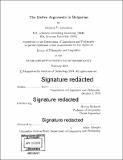| dc.contributor.advisor | Norvin Richards. | en_US |
| dc.contributor.author | Iovtcheva, Snejana P. | en_US |
| dc.contributor.other | Massachusetts Institute of Technology. Department of Linguistics and Philosophy. | en_US |
| dc.date.accessioned | 2019-10-04T21:33:57Z | |
| dc.date.available | 2019-10-04T21:33:57Z | |
| dc.date.copyright | 2019 | en_US |
| dc.date.issued | 2019 | en_US |
| dc.identifier.uri | https://hdl.handle.net/1721.1/122427 | |
| dc.description | Thesis: Ph. D. in Linguistics, Massachusetts Institute of Technology, Department of Linguistics and Philosophy, 2019 | en_US |
| dc.description | Cataloged from PDF version of thesis. | en_US |
| dc.description | Includes bibliographical references (pages 162-174). | en_US |
| dc.description.abstract | This dissertation is a study of the syntactic and semantic properties of arguments marked with a dative clitic in Bulgarian. Contemporary Bulgarian has been claimed to have lost its Case system compared to its previous historical stages. Yet, as the current study demonstrates, the language has systematically utilized a morphological marker in the form of a dative clitic to identify a particular set of arguments across a wide variety of structural environments - the dative arguments. The major proposal advanced here is that dative arguments are treated uniformly by the grammar of the language because they uniformly represent peripheral arguments introduced in the specifier of a functional head that assigns to them morphological dative Case. | en_US |
| dc.description.abstract | Despite the fact that these arguments might assume a wide variety of thematic interpretations (recipients, goals, possessors, sources, beneficiaries, malefactives, etc.), I demonstrate that their meaning is derived structurally from the position in which they are licensed. Crucially, only one dative occurs within a structural domain. The intra-linguistic comparison of a variety of constructions further leads to the conclusion that in each context datives are prominent arguments introduced at the periphery of a structural domain. This proposal explains the ability of datives to bind nominative subjects, to serve as structural subjects in impersonal predicative constructions, and to interact with nominative subjects in bi-clausal environments. | en_US |
| dc.description.abstract | To capture their uniform structural distribution and simultaneously to account for the wide range of thematic meanings, I propose that the argument introducer is a semantically underspecified functional head of the High APPL(icative) type as defined in Pylkkinen (2002/2008). The current study contributes to the ongoing theoretical debate of argument structure and argument interpretation and introduces Bulgarian as a relevant language when it comes to the study of datives in double object constructions, 'quirky' dative subjects, and dative possessors. | en_US |
| dc.description.statementofresponsibility | by Snejana P. Iovtcheva. | en_US |
| dc.format.extent | 174 pages | en_US |
| dc.language.iso | eng | en_US |
| dc.publisher | Massachusetts Institute of Technology | en_US |
| dc.rights | MIT theses are protected by copyright. They may be viewed, downloaded, or printed from this source but further reproduction or distribution in any format is prohibited without written permission. | en_US |
| dc.rights.uri | http://dspace.mit.edu/handle/1721.1/7582 | en_US |
| dc.subject | Linguistics and Philosophy. | en_US |
| dc.title | The dative arguments in Bulgarian | en_US |
| dc.type | Thesis | en_US |
| dc.description.degree | Ph. D. in Linguistics | en_US |
| dc.contributor.department | Massachusetts Institute of Technology. Department of Linguistics and Philosophy | en_US |
| dc.identifier.oclc | 1120128067 | en_US |
| dc.description.collection | Ph.D.inLinguistics Massachusetts Institute of Technology, Department of Linguistics and Philosophy | en_US |
| dspace.imported | 2019-10-04T21:33:56Z | en_US |
| mit.thesis.degree | Doctoral | en_US |
| mit.thesis.department | Ling | en_US |
